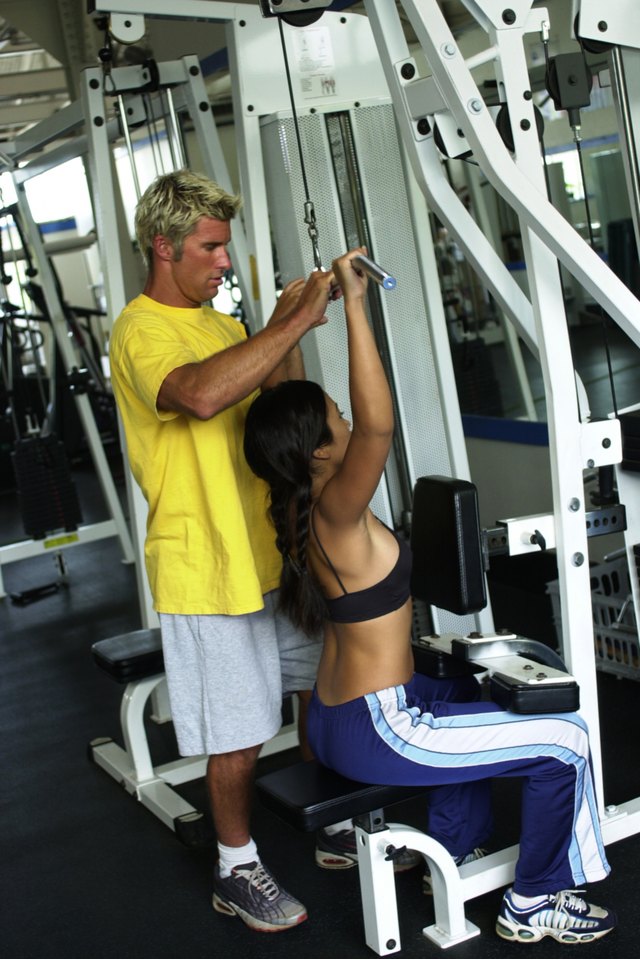The Difference Between Reverse Grip Lat Pulldowns and Wide Grip Lat Pulldowns

Having strong upper back muscles are just as important as having strong chest, shoulder and arm muscles. Exercise physiologist Peggy Kraus M.A., suggests that exercising your upper back helps correct postural imbalances to help you look more graceful. While the classic back exercises like pull-ups,chin-ups, and deadlift are supremely popular, the lat pulldown is becoming a staple of any bodybuilding back workout. The lat pulldown works your upper back, and its various grips, such as the reverse grip and the wide grip, determine the effectiveness of the exercise for certain areas of your body.
What are the targeted Muscle groups in lat pulldown?
The lat pulldown is a multi-joint exercise that primarily targets your latissimus dorsi muscles or lats -- the large fan-shaped muscles on either side of your back. The exercise also works a range of other muscles on your upper back and lower back such as the rhomboids, shoulder blades, teres major, the middle and lower trapezius and the rear deltoids. Other muscles that experience muscle activation include your biceps brachii, triceps, and the outer portion of your chest.
How to do Lat Pulldown?
A lat pulldown is a workout that cannot be done with dumbbells or barbells and is done with a lat pulldown machine. Attach a double stirrup handle on an upper pulley cable on a cable machine and set an appropriate weight. To get into the starting position, sit on the bench, placing your thighs under the support pad, and grasp the handle with both hands. Continue the exercise with proper form by pulling down the handle to your upper chest, while keeping your back straight. Slowly return the handle up by extending your arms and shoulders.
What are the Effectiveness of hand positions?
Your grip on the lat pulldown bar determines how much you engage your lats and which other muscles you emphasize. While normally an overhand grip, also called a pronated or neutral grip, is used, many use other grips for different purposes. According to a study published in the November 2002 issue of "The Journal of Strength and Conditioning Research,” wide-grip lat pulldowns to the top of the chest engage your lats more than reverse-grip lat pulldowns. Reverse-grip, also called a supinated grip or underhand grip, lat pulldowns with your palms facing you shift the focus onto your biceps. This grip also allows you to use more weight.
Grip Width
When performing wide-grip lat pulldowns, use a grip that is slightly wider than shoulder-width. A helpful guide is ensuring your forearms are roughly parallel as you pull the bar down. Using a wider grip may be uncomfortable and limit your full range of motion, thus engaging fewer muscle fibers and lessening the effectiveness of the exercise. Perform reverse-grip lat pulldowns with a shoulder-width grip and keep your elbows in front of you. Use a narrower grip if you find that more comfortable.
How to be safe doing lat pulldown?
Do not pull the bar down behind your head when doing wide-grip lat pulldowns. "The Journal of Strength and Conditioning Research" notes it is not as effective as lat pulldowns to the top of your chest. According to strength coach Paul Chek, writing for the University of Washington, behind-the-head lat pulldowns place excessive stress on your shoulders and may cause injury. Avoid hurting your shoulders by pulling the bar down to the top of your chest. Be sure to control your reps and not overexert your body by doing too many reps.
Options
Another option involves a fixed-width V-bar and using a close grip with palms facing. According to "The Journal of Strength and Conditioning Research” study, this grip activates your chest muscles, but works your lats less than wide-grip pulldowns to the chest. Vary your upper back exercises by alternating between wide pulldowns to your chest, reverse-grip pulldowns and close-grip pulldowns.
Writer Bio
This article was written by the CareerTrend team, copy edited and fact checked through a multi-point auditing system, in efforts to ensure our readers only receive the best information. To submit your questions or ideas, or to simply learn more about CareerTrend, contact us [here](http://careertrend.com/about-us).
